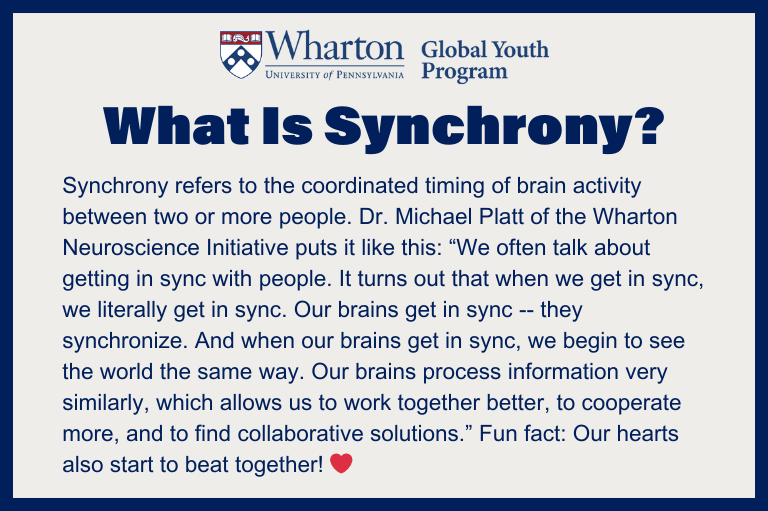Brainpower and Business: How Neuroscience Gets Inside Your Head


When was the last time you actually thought about how you think?
Elizabeth Zab Johnson, executive director of the Wharton Neuroscience Initiative at the Wharton School of the University of Pennsylvania, is all about brainpower. She likes to say that her team’s research helps people, businesses and society think broadly about the three-pound organ inside our heads and how it might impact our work and our lives.
That mission takes on powerful meaning these days as artificial intelligence enables computers to learn tasks in ways that mimic human intelligence. How can the two – grey matter and machine design — work together efficiently and effectively? And how might that combination improve business insights and operations?
The Wharton Neuroscience Initiative partners with companies to research questions like this. Michael Platt, founder and director of the Wharton Neuroscience Initiative and a Wharton and Penn professor of marketing and neuroscience, believes that neuroscience can have a major impact on business in everything from marketing and brand strategy to leadership. He is a driving force behind the science of neuroeconomics, to help us better understand decisions in all these areas. He and his colleagues regularly collect data to demonstrate the value of using a neuroscience approach to solve challenges in business.
Analyzing the Effects of Advertising
A recent example of this is the Neuroscience Initiative’s research partnership with RMT (Research Measurement Technologies), an AI-based motivational analytics system led by senior executives with backgrounds in media, entertainment and advertising. RMT introduces disruptive technologies into these industries to improve outcomes, such as the return on investment for agencies that create advertising to sell products and services.
RMT has been working with the Wharton Neuroscience Initiative on a big advertising study that links neural signals in the brain to inner experiences of brand valuation. The ultimate goal: helping brands grow by understanding how consumers make choices.
In a recent press release related to the research, Bill Harvey, the chairman of RMT, talked about some of their discoveries. The results of the current study have shown, for example, that television environments produce far higher levels of the four sales-predictive brain measures (memory, brain attention, approach, and synchrony,) compared to digital environments.
“In the last 10-year shift to digital media, fewer than one in five major brands have grown market share,” Harvey noted. “Digital direct response capabilities have been used to reap immediate sales, but this has slowed brand growth itself. Brands grow when they resonate with the motivations of customers. This requires storytelling, more than fast flickers of attention.”
Put on Your Thinking Caps
More to come from this Wharton-industry research collab, including some new-age, high-tech data gathering.
In the last few years, the Wharton Neuroscience Initiative – and more specifically Dr. Platt – has helped to develop quality wearable neurotechnology. “A whole variety of gizmos are coming to market,” noted Professor Platt during a conversation with Wharton’s Eric Bradlow. “Combining that with advances in AI and machine learning puts us in a position to really capitalize on the ability to measure brain activity in the real world at scale – thousands, maybe millions of people – in a much wider array of activities than is possible in the laboratory.”
Wharton Neuroscience’s brand-focused research with RMT is moving into that high-tech head space. “Because of Dr. Platt’s contribution to the development of Cogwear, highly accurate EEG headbands [that] can be used in people’s own homes, we’re looking forward to a series of studies in homes rather than in the lab,” said Jin Ho Yun, post-doctoral researcher at the Wharton School who is working on the RMT studies. “This will enable measurement of natural exposure to advertising and will be linked to household level sales data.”

How are Michael Platt and his colleagues using a neuroscience approach to tackle the challenge of creating more effective advertising to improve brand value?
What is cogwear and how is it helping to improve data collection for the Wharton Neuroscience Initiative?
Do you think organic intelligence and artificial intelligence can co-exist and even achieve synchrony? Tell us more in the comment section of this article.
Hero Image Credit: Anthony Tran, Unsplash
I believe that organic intelligence and artificial intelligence will achieve synchrony in the future. A skeletal process is already seen through neuralink from Elon Musk, where already your brain waves are being analyzed by a machine using artificial intelligence. But more in a general note, I believe that the more humans use Artificial intelligence, the more we will start to think how the computers and machines think, especially since artificial intelligence is so widespread and readily available so that children on their ipads can access Chatgpt anywhere with an internet connection. I also believe that the more Artificial intelligence is used through the world, the more analytical information it gains in order to grow and to learn, so in the near future, I think maybe in 2-3 years, Ai and organic intelligence will reach an equilibrium point where both computers and humans will partially think like a “human”, and to some degree, humans will start to think more like a robot.
The idea of organic and artificial intelligence coexisting and achieving synchrony was always cool to me. As a kid watching sci-fi movies, it felt like a distant future—but with today’s rapid advancements in AI and machine learning, that future seems closer than ever. Technologies like brain-computer interfaces (BCI) are making this synergy possible. For instance, EEG headbands (such as Cogwear) can now measure brain activity and enable users to interact with digital devices in real time. We’re also seeing neuroadaptive interfaces in VR systems and injury recovery apps, proving that AI and human intelligence can work together in meaningful ways.
However, what made my eyebrow frown was BCI’s application in the business context. As shared in this article, the Wharton Neuroscience Initiative is working on using neuroscience to refine marketing strategies and boost ad ROI by tapping into consumer psychology. While this could make advertising more effective, it also raises serious ethical questions for me. The thought of companies analyzing brainwaves to understand purchasing decisions feels invasive. Our subconscious reactions are deeply personal—should businesses really have access to them? When any business opens up the window of our subconsciousness, analyzing brainwaves for decision-making, it crosses a line between understanding consumer behavior and exploiting personal cognition.
Privacy is another major concern. Right now, we (mostly) know what data we’re sharing with apps—location, browsing history, etc.—yet exploitation still happens, even though we must give consent before signing up for anything. I’ve lost count of how often I’ll talk about craving sushi with friends, only to see it plastered across my food delivery app minutes later. It almost felt like the artificial intelligence was syncing with my brain. But with BCIs, the risks are even murkier: What exactly are we consenting to share? Can we trust companies to only use brain data for benign purposes? Unlike app permissions, neural data feels far more intimate—and harder to regulate.
There’s no denying AI’s potential to improve lives for all. Yet, we must consider where these technologies could lead, whether for the better or for the worse. If we envision organic and artificial intelligence coexisting successfully, I believe we need to draw a clear line between enhancing users’ experiences and infringing upon their autonomy. The future of organic and artificial intelligence in harmony could be transformative, but only if we prioritize ethics alongside innovation. Because the benefits shouldn’t come at the cost of our privacy or free will.
With the rising innovation of artificial intelligence (AI), it is clear that machine learning, where AI learns from past mistakes, will pave humanity’s future. Platt and his colleagues believed that neuroscience would impact business specifically in marketing and brand strategy, by collecting data to solve the significant challenges that exist.
Fortunately, the recent partnership with Research Measurement Technologies (RMT) improves the outcomes, as evidenced by the investment in advertising for agencies. For instance, RMT connects the neural signals to the experiences of brand valuation. Viewing this progressive collaboration of AI and neuroscience, I wondered how neural signals in the brain could be readily measured and contribute to the business’s growth. As Harvey said, digital media has helped market share grow further, and I agreed that the solution was to incorporate customers’ opinions into brand marketing.
Typically, brand marketing emphasizes the quality of its products to customers. Accordingly, if RMT contributes to getting involved in the customers’ storylines by demonstrating where they would utilize the items, their reasons to spend will consequently increase. For instance, saying “Buy the North Face Glacier 3000 Jacket. 100% polyester. Waterproof. Shop now.” won’t always work; instead, observing the necessities of customers through accurate technology would help those remember what they should do. The embedded memory of inner experience, with RMT, would rise to the surface for consumers’ choices.
As someone interested in neuroscience, I often think about the potential for human brain and AI collaboration. With the interference of cogwear, which accurately evaluates and allows studies to be conducted even at home, not only would the brands be able to solve the current issues, but researchers would also have easier ways to find the results of the brain. Therefore, organic intelligence and AI could achieve synchrony, as Jin Ho-yun mentioned about measuring natural exposure to advertising and linking it to household-level sales data.
Currently, I feel this technology could be adopted in various aspects in other brain studies since “machine learning”, which is the new AI technology that could evolve, has participated in the field. Soon, the partnership between neuroscience and technology will address the gaps we currently have.
I believe organic intelligence and artificial intelligence can absolutely coexist and achieve some kind of synchrony. However, it’ll likely differ from the synchrony we share with other people. Even though AI may surpass our intelligence in some areas, it’ll never be entirely like us. This is actually a good thing because synchronizing with AI could let us complement each other. There’s plenty of work and research ahead to get there, but I’m pretty sure it’ll happen someday. That’s why Cogwear is so important. Like smartphones, which became a top way to collect massive data, scientists need tools people can use at home. That’s what Cogwear does—a headband gathering brain data to help the Wharton Neuroscience Initiative better understand our minds. With this detailed data, companies can advertise in a more targeted, effective way, boosting brand awareness and value.
It feels like emerging tech, requiring lots of studies since it blends AI—a fairly new field with unknown limits—and the brain. It is said that we know more about space than our own brains, so it’s still a mystery. Neuroscience is definitely worth pushing forward. I find it super interesting and can’t wait to see more results from the RMT and Wharton Neuroscience Initiative collaboration.